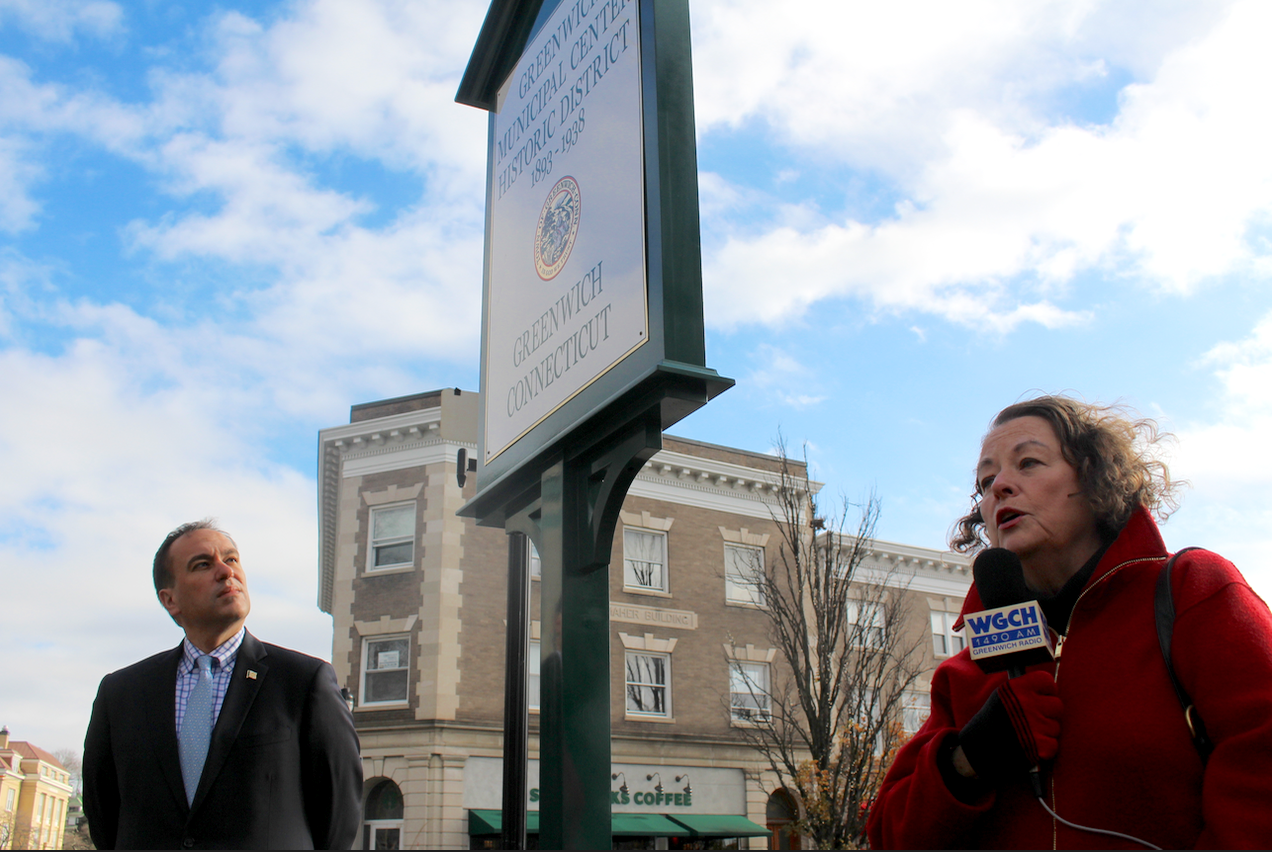A group of Town leaders and volunteers gathered outside the Havemeyer building on Monday to dedicate the first of nine historic markers.

Jake Whitehead, architect at Charles Hilton Architects, who did the shop work to prepare the sign; Daniel Pardy, Associate Partner at Charles Hilton Architects, who designed the sign and worked with Town staff on the installation; Diane Fox, recently retired Director of Planning and Zoning and Chair of the Greenwich Preservation Network of the Greenwich Historical Society, who coordinated the meetings; Davidde Strackbein, Chair of the Greenwich Historical Society and of the 375th Anniversary, who provided the funding from the 375th Anniversary Fund to create the sign; Debra Mecky, Executive Director of the Greenwich Historical Society, who edited the text for the sign (extract of Historic District nomination) and Chuck Hilton, Principal, Charles Hilton Architects, Nov. 30, 2015. Credit: Leslie Yager
The group included First Selectman Peter Tesei, along with Davidde Strackbein, who is the president of the board of the Historical Society of Greenwich, and Diane Fox, the former director of Greenwich’s Planning and Zoning Dept, who now leads the Greenwich Preservation Network, initiated the project.

The Greenwich Municipal Center Historic District sign is located outside the Havemeyer building, with the former US Post office on Greenwich Ave in the background.
The preservation network, formed in March 2015, is an arm of the Greenwich Historical Society. The group is a mix of public and private preservation-minded organizations. The group also includes businesses and individuals invited by the Historical Society to address new economic and governmental incentives for preservation.
The group aims to educate the community about Greenwich’s architecturally significant buildings and lend a stronger, more unified voice for preservation in town.

Diane Fox thanked Chuck Hilton, a member of the preservation network, who designed the sign and got the contractors to create the sign. “It’s a beautiful sign and gives a history of the area,” she said.
“The purpose of our group is to educate the population about the uniqueness of Greenwich’s historical and architectural buildings and sites,” Fox said, adding that marker program works toward that end.
Fox said her newly formed group decided to kick off the series of signs with the Municipal Center Historic District outside Havemeyer Building because it was the first historic district the town established around 1979.
Fox thanked the Board of Selectmen, DPW’s Jim Michael and Joe Roberto, Parks & Rec Dept director Joe Siciliano, Greenwich Schools Superintendent McKersie and Facilities Director Ron Matten.
“It just goes to show that different departments can work together,” Fox said, adding that the Greenwich 375 group funded the sign, which was installed in time for the 375th anniversary parade.

Davidde Strackbein, president of the board of the Historical Society of Greenwich.
Davidde Strackbein, the chair of the Board of the Historical Society of Greenwich, said that the first zoning regulations were created in Greenwich in 1925.
Then, in 1926 there were seven major subdivisions, and what had been farmland became elegant planned development including Deer Park, Khakum Wood, Indian Harbor and Milbrook.
“What grew out of that was zoning, a map of zoning and a Zoning Board of Appeals, which followed in a democratic society. Following that, a building department was created,” Strackbein said.
In 1931 the Greenwich Historical Society was born. In 1933, the first town subdivision regulations were instituted.
“In the 1960s, not just land, but conservation became important, and an Architectural Review Committee was created,” Strackbein said, adding that the Havemeyer building was constructed in 1892 with funds donated by H.O. Havemeyer, when the population was 10,000. In the 1920s, the town’s population was 26,000. By the 1970s there were 60,000 residents.
In the 1970s the Greenwich Land Trust and the Historic District Commission were created.
Strackbein said that in 2002, the National Trust for Historic Preservation called tear-downs were a national epidemic. “We’re seeing that again seeing today,” she said. “With every street you go down, you see a DEMOLITION sign and you say to yourself, ‘What is going on? So in 2015 we formed a forum for public and private organizations to unite together to support the preservation goals that had been created by the Town of Greenwich, and to foster town-wide community projects to educate the community about the value of historic preservation and landscapes and streetscapes of the Town of Greenwich.”
“The Historical Society is pleased to bring these leaders together, because it is critical to preserve the historical identity and character of Greenwich. People are drawn to communities that preserve a strong sense of place,” Debra Mecky said.
“The project’s historic signage not only identify an area, but also describe it, provide a map and tell you the organizations that you can call. The signs also each include a QR Code, so people can find out even more with your iPhone,” Strackbein said.
Mr. Tesei said that there was a movement to develop Greenwich Common, but Ruth Sims, the former Greenwich First Selectwoman worked with Planning and Zoning to make sure that it was preserved as parkland.
He described the sign as more than just a marker, but an educational tool for residents and visitors. “I think of this areas as the epicenter of the entire town of Greenwich. When you think about Greenwich being a 50 square miles. The nucleus of activity started here.”
In the works are signs for the Strickland Road Historic District (c. 1728 – 1976), the River Road-Mead Avenue Historic District (1835 – 1910), the Greenwich Avenue Historic District (1878 – 1940), the Fourth Ward Historic District (1840 – 1925), the John Street-Round Hill Historic District (c. 1728 – 1925), the Stanwich Historic District, the Glenville Historic District and the Putnam Hill Historic District (c.1730 – 1909).
See also: Honoring Davidde Strackbein, Driving Force Behind Greenwich’s 375th Anniversary